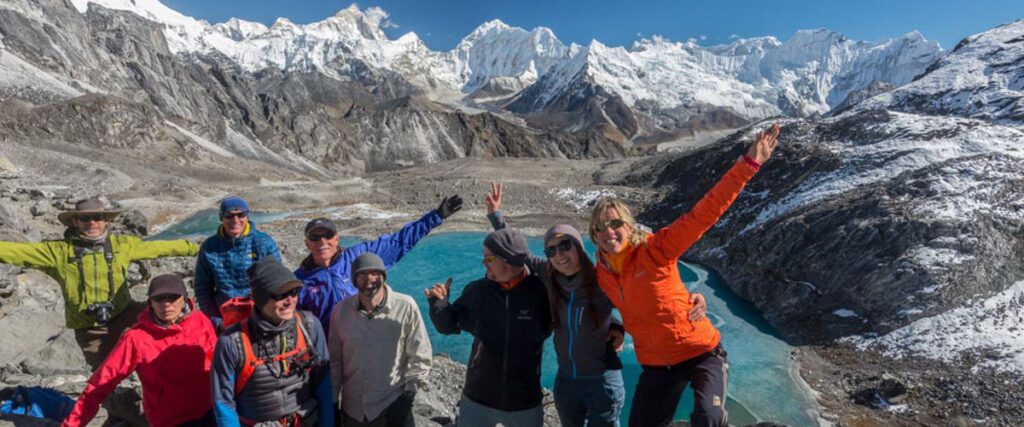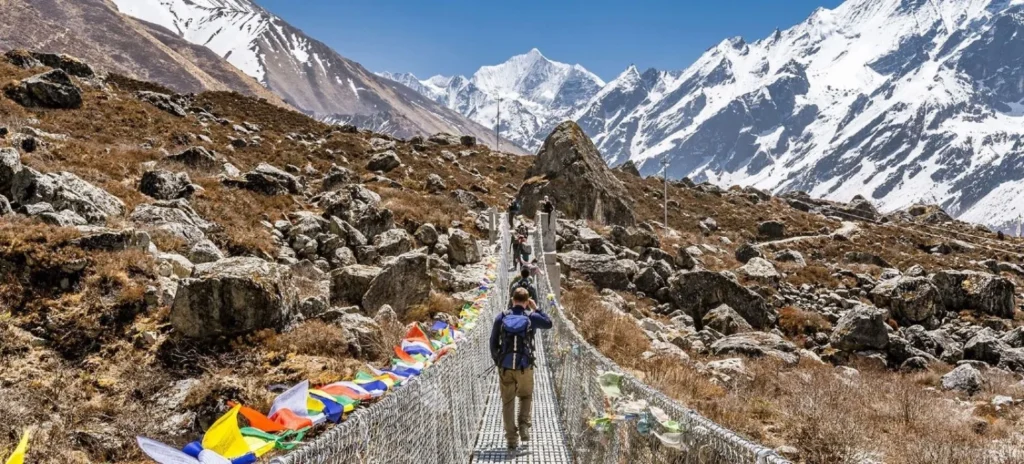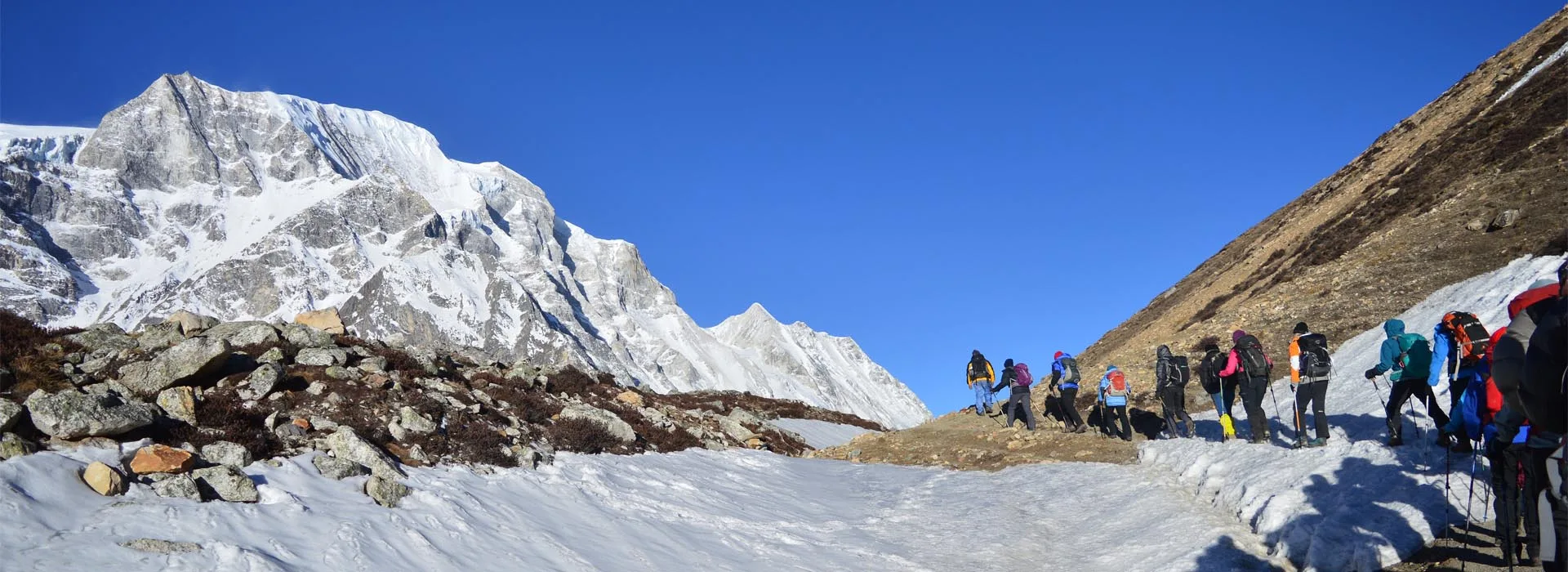Trek Nepal, a land of majestic mountains, ancient cultures, and breathtaking landscapes, piques the interest of adventurers from around the globe. Whether you dream of standing at the foot of Mount Everest or exploring hidden valleys, preparing properly is key to an unforgettable and safe journey.
This ultimate guide will highlight everything you need to know, from choosing your perfect trek to packing smart and navigating common challenges. So, read along and get ready to set out on the adventure of a lifetime!
Popular Trekking Regions in Nepal
Nepal presents an incredible variety of trekking regions, each offering unique scenery, cultural experiences, and levels of challenge. Therefore, it can be quite confusing to pick your destination as there is no lack of options. So, deciding where to go is the first exciting step in planning your trekking adventure. Here are five of the most popular regions that draw trekkers year after year:
Everest Region (Khumbu)
The Everest Region, also known as Khumbu, is home to the world’s highest peak, Mount Everest. This iconic region offers more than just a glimpse of Everest; it’s a deep dive into Sherpa culture, ancient monasteries, and stunning glaciers. Throughout this trek route you’ll walk through charming villages like Namche Bazaar, known as the gateway to Everest, and experience the unparalleled beauty of the high Himalayas.
- Duration: Typically 12-16 days
- Highlights: Everest Base Camp, Kala Patthar (for incredible Everest views), Namche Bazaar, Tengboche Monastery, Sherpa culture, stunning high-altitude scenery.
- Difficulty: Moderate to challenging, mainly due to high altitude and long walking days. Requires good physical fitness.
Some of the best trekking routes in the Everest Region are:

- Everest Base Camp Trek
- Everest Base Camp Trek – Chola Pass
- Everest base Camp Trek with Renjo and Chola Passes
- Everest via Gokyo Lakes
- Lower Everest Region Trek
- Dudh Kunda Trek
- Solu Sherpa Village Trek
- Rolwaling Valley Trek
- The Great Solu loop
Annapurna Region
The Annapurna Region is one of Trek Nepal’s most diverse trekking areas, famous for its incredible range of landscapes, from lush subtropical forests to arid mountain deserts. It offers a mix of classic tea house treks and more remote adventures, highlighting the vibrant Gurung and Magar cultures, hot springs, and panoramic views of the Annapurna and Dhaulagiri mountain ranges.
- Duration: 7-21 days, depending on the chosen route (e.g., Annapurna Base Camp, Annapurna Circuit, Poon Hill).
- Highlights: Annapurna Base Camp, Thorong La Pass (on the Circuit), Poon Hill sunrise view, diverse landscapes, local Gurung and Magar villages, and natural hot springs.
- Difficulty: Varies from easy (Poon Hill) to challenging (Annapurna Circuit due to the high pass).
Some of the best trekking routes in the Annapurna Region are:
- Annapurna Circuit Trek
- Annapurna Circuit Trek
- Annapurna Balcony Trek
- Annapurna Sanctuary Trek
- Annapurna Circuit with Tilicho Lake Trek
- Annapurna Gurung Trail Treks
- Nar Phu Valley Trek
- Annapurna Ridge Trails Trek
- Kali Gandaki Trek
Langtang Region

Closer to Kathmandu, the Langtang Region offers a fantastic trekking experience without the long journey to the Everest or Annapurna areas. Known as the “Valley of Glaciers,” it’s celebrated for its pristine natural beauty, deep valleys, and unique Tamang culture. Despite being affected by the 2015 earthquake, the region has largely recovered, and its trails are welcoming trekkers once again.
- Duration: 7-14 days
- Highlights: Langtang Valley, Kyanjin Gompa, Tserko Ri/Kyanjin Ri (for panoramic views), Gosainkunda Lakes, Tamang heritage.
- Difficulty: Moderate. It involves steady ascents and descents.
Some of the best trekking routes in the Langtang Region are:
Manaslu Region
The Manaslu Circuit Trek offers a true adventure for those seeking a more remote and less crowded experience. This trek circles Mount Manaslu, the world’s eighth-highest mountain, and provides a proper cultural immersion into untouched Nepalese villages. It’s a restricted area, meaning you need special permits and usually a guide, which helps preserve its unique nature.
- Duration: 14-18 days
- Highlights: Manaslu Circuit (circling Mt. Manaslu), Larkya La Pass, remote villages, Tsum Valley (optional extension), unspoiled cultural experience.
- Difficulty: Challenging, involves crossing a high pass (Larkya La), and requires good physical stamina.
Some of the best trekking routes in the Manaslu Region are:
Upper Mustang Region
Stepping into the Upper Mustang is like entering a different world. This ancient Buddhist kingdom, often called a “mini-Tibet,” is a land of stark, arid landscapes, colorful rock formations, and centuries-old monasteries. As a restricted area, it has carefully preserved its unique culture and traditions, making it a truly special and exclusive trekking destination. It’s also in a rain-shadow area, making it ideal for monsoon trekking.
- Duration: 10-18 days
- Highlights: Lo Manthang (the walled city), ancient caves, monasteries, unique Tibetan culture, and arid high-desert landscapes.
- Difficulty: Moderate. While not extremely high in altitude, the terrain can be rugged and dusty.
Best Time to Trek in Nepal
The success and enjoyment of your trekking adventure in Trek Nepal greatly depend on choosing the right time of year. Nepal’s weather varies significantly with the seasons, affecting trail conditions, visibility, and the overall trekking experience.
Best Seasons to Go Trekking in Nepal
Autumn (September to November):
This is widely considered the best trekking season in Nepal. The monsoon rains clear the air, leaving behind crisp, clean skies and spectacular mountain views. During this season, temperatures are mild and stable, making for comfortable walking conditions. Furthermore, major festivals like Dashain and Tihar often fall during this period, offering a wonderful cultural insight.
Spring (March to May):
Spring brings warmer temperatures and vibrant blooms, especially rhododendrons, which cover the hillsides with vibrant colors. The mountain views are generally clear, and while some high passes might still have snow early in the season, the trails are usually excellent. It’s a fantastic time for birdwatching and enjoying the rich biodiversity.
Winter (December to February):
For those who don’t mind the cold and desire a quieter experience, winter can be beautiful. Lower altitude treks are often perfect, with clear skies. However, higher passes can be snowbound and extreme cold is common, requiring specialized gear and experience.
Monsoon (June to August):
While most popular treks are challenging due to heavy rain, muddy trails, and leeches, the monsoon season is ideal for rain-shadow regions like Upper Mustang and Dolpo. These areas receive little rainfall and transform into unique, arid landscapes, offering a distinct adventure.
How to Prepare for Trekking in Nepal
Once you’ve chosen your trek and the best time to go, it’s time to get your body and mind ready for the challenge. Proper preparation can make all the difference in enjoying your trek.
Physical Training
- Cardiovascular Fitness: Engage in activities that get your heart rate up, such as running, cycling, swimming, or brisk walking. Aim for at least 3-5 sessions per week, gradually increasing duration and intensity over several months.
- Strength Training: Focus on strengthening your legs, core, and back. Squats, lunges, step-ups, planks, and push-ups are excellent for building the muscle groups you’ll rely on while carrying a pack and navigating varied terrain.
- Hiking Practice: The best preparation is hiking! Start with shorter hikes and gradually increase the distance, elevation gain, and the weight of your backpack to simulate real trekking conditions. Include uphill and downhill sections.
- Flexibility and Balance: Incorporate stretching, yoga, or Pilates into your routine. Good flexibility helps prevent injuries, and improved balance is crucial for uneven trails.
Mental Preparation
- Realistic Expectations: Understand that trekking will have its ups and downs. There will be challenging moments, but focusing on the journey and the incredible experience will help you push through.
- Positive Mindset: Cultivate a positive attitude. The Himalayas can be demanding, but a strong mental game will keep you motivated.
- Research and Knowledge: Learn about your chosen trek, the local culture, and potential challenges. Knowing what to expect reduces anxiety and helps you feel more confident.
- Breathing and Mindfulness: Practice deep breathing exercises. These can be incredibly useful at altitude and for staying calm and focused during demanding sections of the trek.
Acclimatization and Altitude Sickness Prevention
- Go Slow, Go High, Sleep Low: This is the golden rule of high-altitude trekking. Ascend gradually, ideally not increasing your sleeping altitude by more than 300-500 meters per day above 3,000 meters. If possible, hike higher during the day and return to a lower altitude to sleep.
- Hydrate Well: Drink plenty of water throughout the day, at least 3-4 liters. Dehydration can worsen altitude sickness symptoms. Avoid alcohol and excessive caffeine.
- Eat Properly: Maintain a balanced diet rich in carbohydrates for energy. Even if your appetite decreases at altitude, try to eat regular, nourishing meals.
- Rest Days: Incorporate rest days into your itinerary, especially when you gain significant altitude (e.g., in Namche Bazaar for Everest treks or Manang for Annapurna). These days are crucial for your body to adapt.
- Listen to Your Body: Pay close attention to any symptoms like headaches, nausea, dizziness, or unusual fatigue. If symptoms worsen, inform your guide immediately and be prepared to descend if necessary.
Essential Documents & Permits For Trekking
Knowing and having all the necessary paperwork is a crucial part of your Nepal trekking preparation. Here’s a breakdown of the documents and permits you’ll need:
- Passport and Visa: Ensure your passport is valid for at least six months beyond your planned departure date. You can obtain a Nepalese visa on arrival at Kathmandu’s Tribhuvan International Airport or from Nepalese embassies/consulates abroad.
- Trekking Information Management System (TIMS) Card: This is a mandatory permit for all trekkers in Nepal, designed to ensure your safety and track your location in case of emergencies. It helps the government manage trekking activities.
- National Park / Conservation Area Permits: Most popular trekking routes pass through protected areas like Sagarmatha National Park (Everest Region) or Annapurna Conservation Area (Annapurna Region). You’ll need an entry permit for these areas. The fees contribute to conservation efforts.
- Restricted Area Permits (RAPs): For certain remote and culturally sensitive regions like Upper Mustang, Manaslu, Dolpo, and Kanchenjunga, you’ll need special restricted area permits. These usually require you to trek with a licensed guide and often in a group through a registered trekking agency. The cost for these permits can be significantly higher and vary by region and duration.
- Travel Insurance: This is non-negotiable. Ensure your policy covers high-altitude trekking, emergency medical expenses, and, importantly, helicopter evacuation, which can be life-saving in remote mountain areas.
Tip: It’s highly recommended to go through a registered trekking agency, like Glacier Safari Treks, as they will handle most of the permit applications and logistical arrangements for you, saving you time and hassle.
Must-Have Trekking Packing List
Packing smart is crucial for a comfortable and safe trek in Nepal. However, overpacking items can lead to downsides. Therefore, here are certain must-have trekking packing lists:
Clothing (Layering System):
- Base Layers: 2-3 pairs of moisture-wicking (e.g., merino wool or synthetic) tops and bottoms. These keep you dry by wicking sweat away from your skin.
- Mid Layers: 1-2 fleece jackets or lightweight insulating layers for warmth.
Outer Layers:
- Waterproof and Windproof Shell Jacket: Essential for protection against rain and wind.
- Waterproof and Windproof Trousers: To keep you dry in wet conditions.
- Trekking Trousers: 2 pairs, quick-drying and comfortable. Convertible trousers are a good option.
- Warm Trousers/Thermals: For colder evenings and higher altitudes.
- Socks: 4-5 pairs of good-quality trekking socks (wool or synthetic) to prevent blisters.
- Headwear: Warm hat (beanie), sun hat (wide-brimmed), buff or neck gaiter.
- Gloves: A pair of warm inner gloves and waterproof/windproof outer gloves.
Footwear:
- Trekking Boots: Crucially, make sure they are well broken-in, waterproof, and provide good ankle support.
- Camp Shoes/Sandals: For comfort around the hotels or tea houses.
Backpacks & Bags:
- Main Duffel Bag (for porter): A sturdy duffel bag (60-80 liters) if you’re using a porter.
- Daypack (for yourself): A 25-35 liter daypack for your essentials (water, snacks, camera, extra layer).
- Rain Covers: For both your duffel and daypack.
- Waterproof Dry Bags/Liners: To protect sensitive items inside your bags.
- Sleeping Bag: Rated for the appropriate temperature based on your trek’s altitude and season (e.g., -10°C to -20°C for high-altitude treks).
- Sleeping Bag Liner (optional): Adds warmth and keeps your sleeping bag cleaner.
Essential Gear:
- Trekking Poles: Highly recommended for stability, reducing strain on knees, and aid on ascents/descents.
- Headlamp/Torch: With spare batteries, electricity can be unreliable.
- Water Bottles/Hydration Bladder: At least 2 liters capacity.
- Water Purification Method: Tablets, drops, or a filter/Steripen.
- Sunglasses: With good UV protection.
- Sunscreen: High SPF, for face and exposed skin.
- Snacks: Energy bars, nuts, dried fruit.
Emergency & First Aid Kit:
- Any prescription medicine you need.
- Pain Relievers like Ibuprofen and paracetamol.
- Antiseptic Wipes/Hand Sanitizer.
- Band-Aids and Gauze Pads.
- Anti-diarrhea medication (e.g., Loperamide).
- Electrolyte sachets.
- Diamox (if prescribed by your doctor).
- Water Purification Tablets (as a backup).
- Small Sewing Kit/Duct Tape.
Common Challenges and How to Overcome Them
Trekking in Nepal, while incredibly rewarding, comes with its own set of challenges. Knowing what to expect and how to handle them can make your journey smoother and more enjoyable.
Altitude Sickness

Altitude sickness is the most significant concern. It happens when your body doesn’t get enough time to adjust to lower oxygen levels at higher elevations.
How to Overcome:
- Slow and Steady: The best defense is a slow ascent. Don’t rush things as it can get more complicated.
- Hydrate: Drink plenty of water.
- Rest Days: Include acclimatization days in your itinerary.
- Listen to Your Guide and Your Body: Guides are experienced in spotting symptoms. If you feel unwell, report it immediately. Descend if symptoms worsen.
Unpredictable Weather
Mountain weather can change rapidly, from clear skies to rain or snow in a matter of hours. Therefore, it has been one of the most common challenges in trekking.
How to Overcome:
- Layering: Pack layers of clothing that you can easily add or remove.
- Waterproof Gear: Always carry waterproof and windproof outer layers.
- Check Forecasts: While not always accurate for high altitudes, a general idea of the forecast helps.
Trail Conditions
Trails can be rocky, uneven, muddy, or snowy, making walking challenging.
How to Overcome:
- Proper Footwear: Wear well-broken-in, sturdy trekking boots with good ankle support.
- Trekking Poles: Use poles for stability and to reduce strain on your joints.
- Watch Your Step: Pay attention to the ground, especially on descents.
Minor Ailments and Injuries
Blisters, stomach upsets, and muscle aches are common on treks.
How to Overcome:
- First Aid Kit: Carry a comprehensive personal first aid kit.
- Hydration & Hygiene: Drink purified water and practice good hand hygiene to prevent stomach issues.
- Listen to Your Body: Don’t push through pain that feels more than just muscle soreness.
Mental Fatigue
Long days of walking, repetitive routines, and potential discomfort can lead to mental exhaustion.
How to Overcome:
- Break Down the Day: Focus on smaller milestones (e.g., reaching the next tea house, lunch stop).
- Enjoy the Views: Take time to appreciate the stunning scenery around you.
- Connect with Others: Share experiences with your trekking companions or local villagers.
- Bring Entertainment: A book, journal, or deck of cards can provide a welcome distraction.
Conclusion: Your Unforgettable Nepal Trek Awaits!
Preparing for a Nepal trek is an adventure in itself, but with the right planning, mindset, and gear, you’re set for an experience that will stay with you forever. From mesmerizing peaks to the warm hospitality of the local people, Nepal offers a journey unlike any other.
So, if you’re ready to turn your dream of trekking in the Himalayas into a reality, start your preparation today. And for a seamless and memorable adventure, consider partnering with a trusted expert.
Glacier Safari Treks has over three decades of experience guiding trekkers through Nepal’s majestic landscapes, ensuring every detail is handled with care and professionalism. Plan your trip with us and let us help you unlock the magic of the Himalayas and create your unforgettable Nepal trek!

